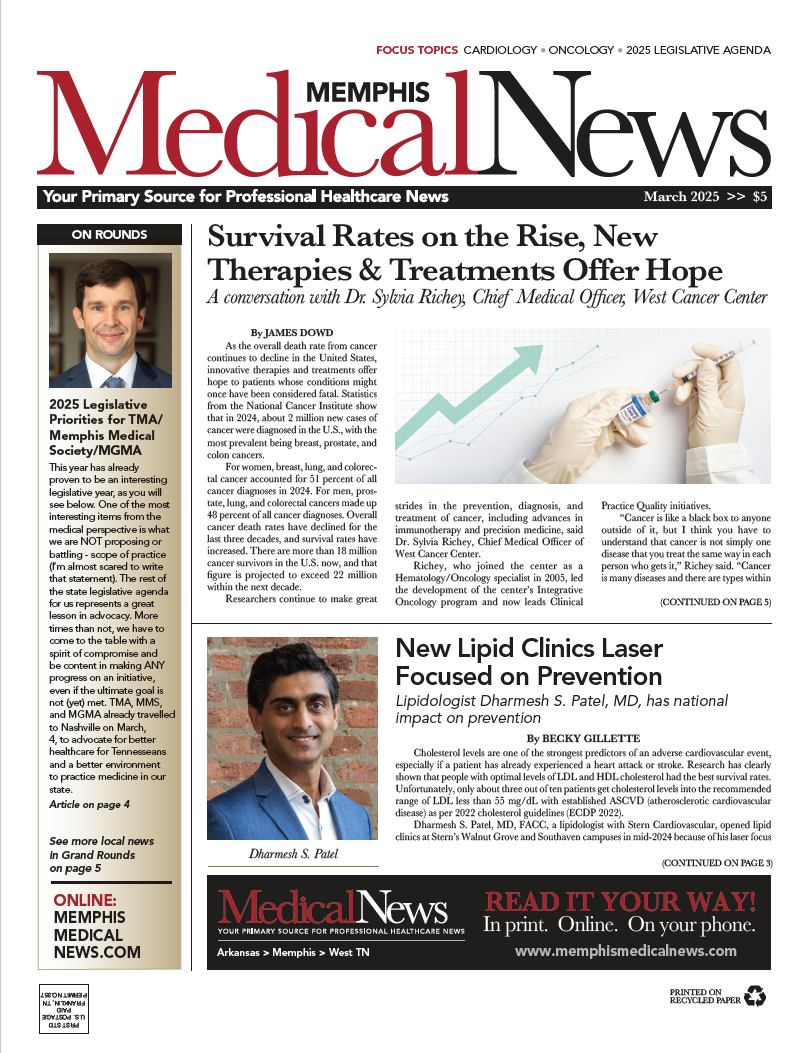Sanjeev Kumar Found Right Place to Put Laparoscopy, Robotics into Practice
When Dr. Sanjeev Kumar came to Memphis in 2013 after a fellowship in gynecology/oncology at the Mayo Clinic, he found a patient population of heavyweights.
With Dr. Kumar's expertise in robotic and laparoscopic surgery, the Baptist Medical Group Gynecology Surgical Center soon became ground zero for obese patients, a group that poses a greater degree of difficulty in surgical procedures.
"When I came to Memphis, we started getting these challenging patients and it was like 'Let the new guy in town have these difficult cases that nobody else wants,'" Dr. Kumar recalled. "Gradually we started developing methods and I started training my staff and operating team, and we started getting excellent results in very obese patients.
"Now in my practice, 80 to 90 percent of my patient population is obese. A lot of other physicians do not feel comfortable dealing with very obese patients, but with the surgery we're offering we have seen the dramatic impact this makes in the patients' lives."
Obesity is measured by Body Mass Index (BMI), which is the weight in kilograms divided by the square of height in meters. Generally, 18 to 25 BMI is normal, somewhat above that is overweight and higher than 30 BMI is obese.
According to the Centers for Disease Control, two-thirds of Americans are overweight, while more than a third are obese.
Under the blunt headline "The Fattest Cities in America," an online publication called WalletHub regularly has Memphis and surrounding metro areas in its top five. Last year the top three were Jackson, Mississippi; Memphis and Little Rock.
"We figured if we're going to do obesity-related work, we are in the right geographic region," Dr. Kumar said. "There is a lot of need for robotic pelvic surgery in obese women. With open surgery in obese patients, you have to cut through more skin, more flesh and therefore you have a much higher rate of infection.
"The greater fat tissue has a lower blood supply, so the healing is slower, you may have long-term wound-care problems and things like that. Robotic surgery eliminates all of those problems to a great extent, and that's a big advantage."
While some 60 percent of the practice is hysterectomy surgery, Dr. Kumar and his team also perform robotic procedures for ovarian tumors and cysts, cervix and uterine cancer, and other pelvic-region surgeries.
Gynecologic cancer, pelvic pain, heavy bleeding and fibroids are other common problems that can be cured with robotic pelvic surgery, the doctor added. He said laparoscopic or robotic surgeries are better methods than open surgery for treating such problems.
Like laparoscopic or keyhole surgery, robotic surgery begins with a few dime-sized incisions in the abdomen, but mechanical arms with surgical instruments become extensions of the surgeon. The first robotic surgery system was approved by the FDA in 2000.
Looking through a magnified, 3D high-definition camera, the surgeon can literally do some heavy lifting with the surgical arms by raising the abdominal wall of an obese patient to better observe the operating field.
The robotic arms also offer 360-degree movement of the surgical instruments, which are manipulated by the surgeon as he cuts, cauterizes, sews and dissects tissue.
"It's a combination of dexterity and computer knowledge, plus a fair bit of eye-hand coordination is required, and obviously lots of practice," said Dr. Kumar, who estimates he has performed some 4,000 robotic pelvic surgeries. "Robotic surgery actually started with the U.S. military, which was looking at the concept of having a surgeon on a ship or city being able to take care of soldiers on a battlefield without physically being there. That's how a lot of robotic surgery concepts evolved, but that's not the routine clinical practice."
He said patients routinely worry that the doctor will not be in the operating room at all and that the surgery will be performed by a robot with a mind of its own.
"Some people will come in and say 'I want to have the surgery, but I want to see the robot first,'" Dr. Kumar said. "They want to make sure a human is controlling the robot. I tell them that I'll be right there controlling the robot myself. It's not the robot that's doing the surgery.
"My fascination with surgery began when I was a kid growing up on a farm in India driving tractors. I wanted to do something manual. I thought I would be good at something where I could work with my hands.
"I went to medical school in India and got my training in robotic and laparoscopic surgery at the Mayo Clinic. That instilled the belief in me that I could really do these challenging cases, especially since there's such a need for them."
He points out that in its annual honor roll rankings, U.S. News and World Report last year ranked the Mayo the No. 1 hospital in six specialties, including gynecology.
Dr. Kumar has an older brother who is a farmer and a sister who is an attorney, both living in India. He and his wife, who uses only one name, is Dr. Sumedha, an internist at Baptist Hospital. They have a daughter, 7, and a son, 3.
Whether the children follow their parents into the medical field will be up to them.
"This is such a fascinating and satisfying field that I would love to encourage them to enter the medical profession and explore being surgeons as career options," Dr. Kumar said. "But honestly, I want to encourage them to develop whatever they want to do. That's when you do the best work, when it comes from within your heart and your mind."
RELATED LINKS:

















